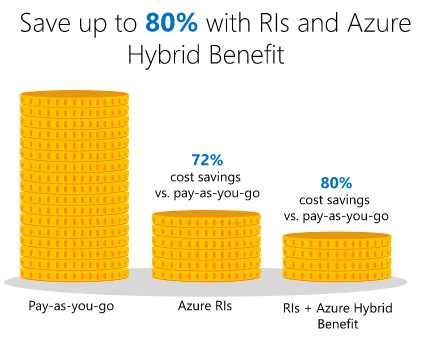Table of Contents
Once you’ve completed your migration to the cloud (for this discussion, Azure cloud), you’ll notice that expenses can start to add up quickly. This post is going to take you through how to reduce expenses with Azure cloud cost optimization.
Your shift to the cloud can be for several reasons including:
- Flexible pay-as-you-go model
- Enhanced security
- Shift from Capex to Opex
- Performance and usability
Regardless of your reasoning for pivoting to the cloud, you’ve made a significant investment in how you operate your IT infrastructure and that investment needs to operate efficiently.
The 4 different steps we’ll discuss as it relates to Microsoft Azure cloud cost optimization include:
- Azure reserved instances
- Azure hybrid-benefit
- Right-sizing VMs
- Storage tiering
Let’s get started.
Azure Reserved Instances
With Reserved Instances, you can commit to 1–3-year agreements with Microsoft that lock in the cost of one or multiple Azure VMs for the agreed upon time period.
The result can Significantly reduce costs—up to 72% compared to pay-as-you-go prices. Lower your total cost of ownership by combining Azure Reserved Instances with pay-as-you-go prices to manage costs across predictable and variable workloads.
In many cases, you can further reduce your costs with reserved instance size flexibility.
Reserved Instance Size Flexibility
When you buy a Reserved VM Instance, you can choose to optimize for instance size flexibility or capacity priority. For more information about setting or changing the optimize setting for reserved VM instances, see Change the optimize setting for reserved VM instances.
With a reserved virtual machine instance that’s optimized for instance size flexibility, the reservation you buy can apply to the virtual machines (VMs) sizes in the same instance size flexibility group. For example, if you buy a reservation for a VM size that’s listed in the DSv2 Series, like Standard_DS3_v2, the reservation discount can apply to the other sizes that are listed in that same instance size flexibility group:
- Standard_DS1_v2
- Standard_DS2_v2
- Standard_DS3_v2
- Standard_DS4_v2
But that reservation discount doesn’t apply to VMs sizes that are listed in different instance size flexibility groups, like SKUs in DSv2 Series High Memory: Standard_DS11_v2, Standard_DS12_v2, and so on.
Within the instance size flexibility group, the number of VMs the reservation discount applies to depends on the VM size you pick when you buy a reservation. It also depends on the sizes of the VMs that you have running. The ratio column compares the relative footprint for each VM size in that instance size flexibility group. Use the ratio value to calculate how the reservation discount applies to the VMs you have running.
Azure Hybrid Benefit
Azure Hybrid Benefit is essentially bringing your own Microsoft licenses into the Cloud as opposed to renting new licenses from Azure. Utilizing Azure Hybrid Benefit, you can save up to 80% when combined with Azure Reserved Instances!
Right Sizing VMs
There are many variables in Azure that can result in you paying more per-VM than you’d expect. For example, your CPU or memory could be overprovisioned.
Or perhaps a legacy application server was assigned a Premium SSD in Azure when a Standard HDD is more appropriate. By right-sizing VMs, VirtuIT’s engineers will use a combination of Azure Insights as well as their own expertise to recommend switching SKUs where appropriate.
This ensures that you’re not overprovisioned and therefore not paying more than you need to.
By analyzing CPU, memory, and IOPS metrics, we are able to make recommendations on SKU changes and tell you exactly how much money per-month you’d save!
Azure Insights
With Azure insights enabled Azure will scan your Cloud environment and make recommendations on not only how you can save money in certain cases, but also improve performance, security, on overall functionality of your environment.
However, not all recommendations are cost savings and may cost you more money. How do you know if it’s worth the extra money?
With VirtuIT’s Cloud engineers, we can analyze all of the data from Azure Insights, explain to you what each recommendation means, and weigh the pros and cons of making those changes to your environment.
Azure Storage Tiering
Making use of Azure as a backup repository? Have archive files that just sit around collecting virtual dust?
We can recommend moving the appropriate data between the Hot Tier (cheapest to access, most expensive to store), the Cool Tier (more expensive to access, a bit less expensive to store), and the Archive Tier (most expensive to access, cheapest to store).
Closing Out Azure Cloud Cost Optimization
In closing, the initial cost assessment to keep your infrastructure hosted in Azure my cause some sticker shock, but with a team of skilled engineers, we can provide the necessary recommendations and implement changes in your environment that can result in hundreds or thousands of dollars in savings each month.




